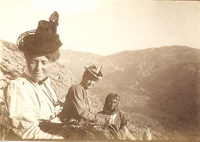Blanche Wheeler Williams facts for kids
Quick facts for kids
Blanche Wheeler Williams
|
|
|---|---|

|
|
| Born | January 9, 1870 |
| Died | December 9, 1936 (aged 66) |
| Alma mater | Smith College |
| Occupation | Archaeologist |
| Known for | Discoveries in Isthmus of Hierapetra and at Gournia |
Blanche Wheeler Williams (born January 9, 1870 – died December 9, 1936) was an important American archaeologist and teacher. She is famous for her exciting discoveries in Crete, especially at a place called Gournia. She worked closely with her friend and fellow archaeologist, Harriet Boyd Hawes.
Blanche studied at Smith College. After college, she taught at her aunt's school. But her real adventure began when she joined archaeological digs in Crete in 1900 and 1901. She later got married in 1904. Even though she didn't return to digging, she helped write a book about her discoveries. She also wrote a book about her aunt and helped her husband with his travel book.
Contents
Early Life and Education
Blanche Emily Wheeler was born on January 9, 1870. Her hometown was Concord, Massachusetts. Her family had a long history in New England. She was very close to her grandmother. Her grandmother introduced her to famous thinkers. These included Ralph Waldo Emerson and Henry David Thoreau.
Blanche went to Smith College and graduated in 1892. There, she studied many interesting subjects. She learned about ancient art and archaeology. She also studied Greek, Latin, drawing, and painting. At Smith, she became good friends with Harriet Boyd. Harriet later became her important partner in archaeology.
Blanche Williams' Teaching Career
For about ten years, Blanche taught at the Wheeler School. This was her aunt's special school in Providence, Rhode Island. She taught Latin, Greek, and English. Blanche also led student trips to Europe. These trips were like grand tours of ancient history. She took breaks from teaching to travel more.
Between 1898 and 1899, she traveled through Greece and Italy. She went with Harriet Boyd and another friend from Smith College. This trip helped prepare her for her future work.
Discoveries in Crete
A big moment came when Harriet Boyd found an ancient tomb. It was a Bronze Age beehive tomb in Kavousi, Crete. Harriet shared her discovery with the Archaeological Institute of America. This led to funding for more digs. The American Exploration Society decided to support her work.
Blanche joined Harriet's expedition in 1901. They first looked for a grand palace in eastern Avgo. They hoped to find something as big as Knossos or Phaestos. Blanche was very skilled at drawing maps. She also drew the artifacts they found. Harriet managed the digging and measurements.
Their early search was slow due to spring rains. But then, a local farmer gave them a tip. They started digging at a new site called Gournia. There, they made an amazing discovery. They found an ancient Minoan town complex!
They first found pieces of vases and bronze items. Soon, they uncovered actual buildings. They found house walls and even a paved road. They quickly told the American Exploration Society about their find. The number of workers grew from 40 to 110 in just one week. Harriet directed this much larger dig.
They found hundreds of artifacts. Blanche drew the most important ones, especially the vases. This dig was very exciting for Blanche. She often wrote home to her students about the amazing finds. This was her only year of digging. Later fieldwork was delayed, and Blanche could not return. The Gournia excavation eventually uncovered over 60 houses. It also had a central plaza and a small palace.
Writing About Ancient Cultures
Blanche Williams wrote an important part of the book about Gournia. Her section focused on a "nature goddess" in Minoan religion. People were very interested in the role of female gods in Minoan Crete. Blanche wrote about a terracotta (clay) female statue. This statue was found in a shrine at Gournia.
Blanche believed that the nature goddess and Minoan women had high status. She supported her ideas by referring to other experts. Her contributions also covered stone vases and seal stones. The book, published in 1908, was highly praised by archaeologists.
Later Life and Legacy
In 1904, Blanche married Emile Francis Williams. He was a businessman who imported oriental rugs. He also collected Chinese porcelain and studied plants. After marrying, Blanche left her teaching job. She kept in touch with Harriet Boyd, who continued her work in Crete.
Blanche did not return to archaeology after Gournia. However, she helped her husband with his travel book about France. She also wrote a biography about her aunt, the educator. Blanche Williams passed away on December 9, 1936, in Cambridge, Massachusetts. She did not have children.
After her death, Smith College received many items from her estate. These included bronzes and porcelains from China and Korea. Some of these items had been shown in famous museums. These included the Fogg Art Museum and the Museum of Fine Arts, Boston. In late 1937, they were put on display at Smith's art gallery.
See also
 In Spanish: Blanche Wheeler Williams para niños
In Spanish: Blanche Wheeler Williams para niños

